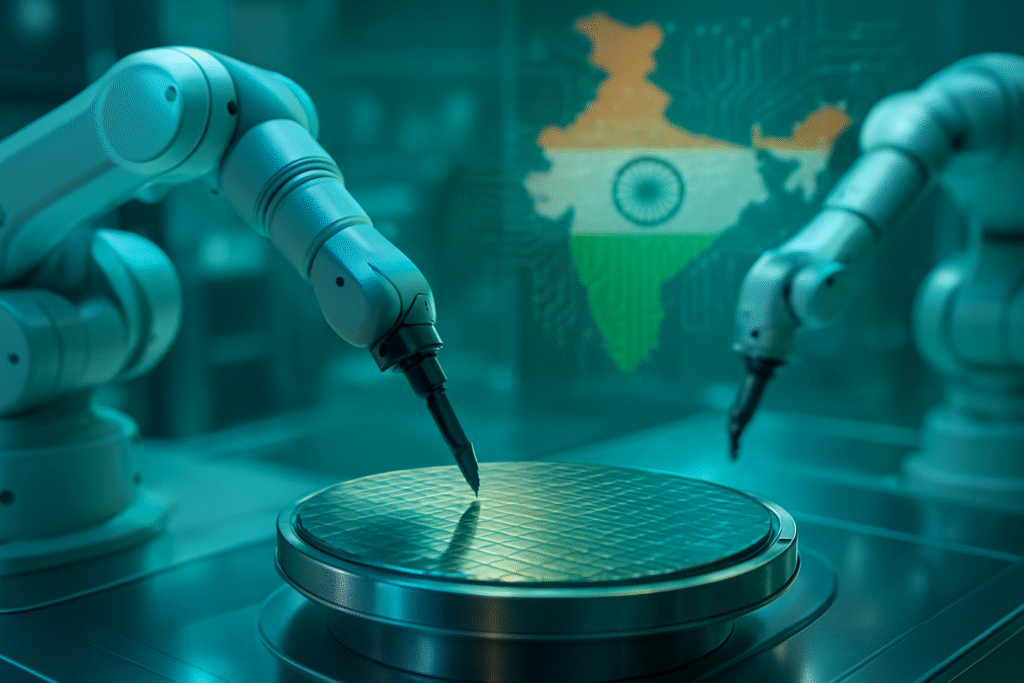
India is embarking on an ambitious journey to transform itself into a global powerhouse in semiconductor manufacturing, driven by a suite of aggressive government policies, substantial financial incentives, and strategic initiatives. This comprehensive national endeavor is not merely about establishing domestic production capabilities; it is a profound strategic move aimed at bolstering the nation's economic sovereignty, reducing critical import dependencies, and securing its technological future in an increasingly digital and geopolitically complex world. The immediate significance of this push cannot be overstated, as it promises to reshape India's industrial landscape, create high-skilled employment, and position the country as a pivotal player in the global technology supply chain.
At its core, India's semiconductor strategy seeks to mitigate the vulnerabilities exposed by recent global supply chain disruptions, which highlighted the precariousness of relying heavily on a few concentrated manufacturing hubs. By fostering a robust domestic semiconductor ecosystem, India aims to build resilience against future shocks and ensure a secure supply of the foundational technology for everything from smartphones and electric vehicles to critical defense systems. This strategic imperative is also a significant economic driver, with projections indicating the Indian semiconductor market, valued at approximately $38 billion in 2023, could surge to $100-$110 billion by 2030, creating hundreds of thousands of jobs and fueling high-tech exports.
The Blueprint for a Semiconductor Superpower: Policies, Incentives, and Strategic Initiatives
India's journey towards semiconductor self-reliance is meticulously charted through several flagship government policies and programs designed to attract investment and cultivate a thriving domestic ecosystem. The National Policy on Electronics (NPE) 2019 laid the groundwork, aiming to position India as a global hub for Electronics System Design and Manufacturing (ESDM) by promoting domestic production and supporting high-tech projects, including semiconductor facilities. Building on this, the India Semiconductor Mission (ISM), launched in December 2021 with a substantial outlay of ₹76,000 crore (approximately US$10 billion), acts as the nodal agency for orchestrating the long-term development of a sustainable semiconductor and display ecosystem.
Under the umbrella of the Semicon India Program, implemented through the ISM, the government offers attractive incentive support across the entire semiconductor value chain. A cornerstone of this strategy is the Production Linked Incentive (PLI) Scheme for Semiconductor Manufacturing, also launched in December 2021 with the same ₹76,000 crore outlay. This scheme provides direct financial support, including grants and tax rebates, covering up to 50% of the project cost for eligible companies establishing semiconductor fabrication units, display fabs, and Assembly, Testing, Marking, and Packaging (ATMP)/Outsourced Semiconductor Assembly and Test (OSAT) facilities. This direct financial backing is a significant departure from previous, less aggressive approaches, aiming to de-risk investments for global players.
Further bolstering the ecosystem, the Design-Linked Incentive (DLI) Scheme, with a budget of INR 1,000 crore (US$114 million), specifically targets local startups and MSMEs, providing financial incentives and design infrastructure support for indigenous chip development. The Scheme for Promotion of Manufacturing of Electronic Components and Semiconductors (SPECS), notified in April 2020, offers a 25% capital expenditure incentive for electronic components and specialized sub-assemblies. Beyond federal initiatives, states like Gujarat, Uttar Pradesh, and Karnataka have introduced their own complementary policies, offering additional capital assistance, land cost reimbursements, and subsidized power tariffs, creating a competitive landscape for attracting investments. The government also allows 100% Foreign Direct Investment (FDI) in the ESDM sector via the automatic route, signaling an open door for international collaboration and technology transfer. These multi-pronged efforts, combined with a focus on talent development and the broader "Make in India" and "Design-led Manufacturing" initiatives, aim to foster not just manufacturing, but also indigenous design and intellectual property generation, ensuring higher economic value and strategic autonomy for India.
Reshaping the Landscape: Impact on Companies and Competitive Dynamics
India's aggressive push into semiconductor manufacturing is poised to significantly impact both domestic and international companies, reshaping competitive dynamics within the global tech industry. Major global chipmakers and display manufacturers are keenly eyeing India's incentives, with several already making commitments. Companies like Micron Technology (NASDAQ: MU), a leading U.S. memory chip manufacturer, has announced a significant investment of $2.75 billion to set up an ATMP facility in Gujarat, signaling a major vote of confidence in India's ecosystem. This move is expected to attract other players in the semiconductor supply chain to establish their presence in the region.
The competitive implications are substantial. For existing global semiconductor giants, India presents an attractive new manufacturing hub, offering diversification away from traditional centers and access to a rapidly growing domestic market. However, it also introduces a new layer of competition, particularly for those who do not engage with India's incentive schemes. Domestically, Indian conglomerates and startups are set to benefit immensely. Companies like Tata Group and Vedanta Limited (NSE: VEDL) have expressed strong interest and are actively pursuing partnerships to establish fabrication units. The government's focus on design-linked incentives (DLI) is specifically designed to nurture local semiconductor design startups, potentially fostering a new generation of Indian "fabless" companies that design chips but outsource manufacturing. This could disrupt the existing product landscape by introducing more cost-effective and customized chip solutions for the Indian market, and potentially for global exports.
The potential disruption extends to the broader electronics manufacturing services (EMS) sector, where companies like Foxconn (TWSE: 2317) and Pegatron (TWSE: 4938), already present in India for smartphone assembly, could integrate more deeply into the semiconductor supply chain by partnering with local entities or expanding their own component manufacturing. This strategic advantage for companies investing in India lies in their ability to leverage significant government subsidies, access a large and growing talent pool, and cater directly to India's burgeoning demand for electronics, from consumer devices to automotive and defense applications. The entry of major players and the fostering of a domestic ecosystem will inevitably lead to increased competition, but also to greater innovation and a more resilient global semiconductor supply chain, with India emerging as a crucial new node.
Broader Significance: Geopolitics, Innovation, and Global Trends
India's semiconductor manufacturing drive transcends mere industrial policy; it is a significant geopolitical move that aligns with broader global trends of supply chain de-risking and technological nationalism. In an era marked by increasing US-China tensions and the weaponization of technology, nations are prioritizing strategic autonomy in critical sectors like semiconductors. India's initiative positions it as a crucial alternative manufacturing destination, offering a democratic and stable environment compared to some existing hubs. This move fits squarely into the global landscape's shift towards diversifying manufacturing bases and building more resilient supply chains, a trend accelerated by the COVID-19 pandemic and ongoing geopolitical realignments.
The impacts are multi-faceted. Economically, it promises to significantly reduce India's import bill for electronics, foster a high-tech manufacturing base, and create a ripple effect across ancillary industries. Technologically, it encourages indigenous research and development, potentially leading to breakthroughs tailored to India's unique market needs. However, the endeavor is not without potential concerns. The immense capital expenditure required for semiconductor fabs, the highly complex technological know-how, and the intense global competition pose significant challenges. Ensuring a steady supply of ultra-pure water, uninterrupted power, and a highly skilled workforce are critical operational hurdles that need to be consistently addressed. Comparisons to previous AI milestones, such as the rise of Silicon Valley or the emergence of East Asian manufacturing powerhouses, highlight the long-term vision required and the potential for transformative economic growth if successful.
Moreover, India's push is a crucial step towards achieving technological sovereignty, enabling the nation to control the foundational components of its digital future. This is particularly vital for national security and defense applications, where reliance on foreign-made chips can pose significant risks. By fostering a domestic ecosystem, India aims to mitigate these vulnerabilities and ensure that its strategic technologies are built on secure foundations. The success of this initiative could fundamentally alter the global semiconductor map, reducing over-reliance on a few regions and contributing to a more distributed and resilient global technology infrastructure, thereby impacting global power dynamics and technological innovation for decades to come.
The Road Ahead: Future Developments and Expert Predictions
The coming years are expected to witness significant acceleration in India's semiconductor journey, marked by both near-term milestones and long-term strategic developments. In the near term, the focus will be on the operationalization of approved projects, particularly the ATMP facilities and the first fabrication units. Experts predict that India's first domestically produced semiconductor chip, likely from a facility like the one being set up by CG Power, could roll out by the end of 2025, marking a tangible achievement. This initial success will be crucial for building confidence and attracting further investment. The government is also expected to continue refining its incentive schemes, potentially introducing new support mechanisms to address specific gaps in the ecosystem, such as advanced packaging or specialized materials.
Long-term developments will likely include the establishment of multiple high-volume fabrication units across different technology nodes, moving beyond assembly and testing to full-fledged chip manufacturing. This will be complemented by a burgeoning design ecosystem, with Indian startups increasingly developing intellectual property for a range of applications, from AI accelerators to IoT devices. Potential applications and use cases on the horizon are vast, spanning across consumer electronics, automotive (especially electric vehicles), telecommunications (5G/6G infrastructure), defense, and even space technology. The "Semicon City" concept, exemplified by Gujarat's initiative, is expected to proliferate, creating integrated clusters that combine manufacturing, research, and talent development.
However, significant challenges need to be addressed. Securing access to advanced technology licenses from global leaders, attracting and retaining top-tier talent in a highly competitive global market, and ensuring sustainable infrastructure (power, water) will remain critical. Geopolitical shifts and global market fluctuations could also impact investment flows and the pace of development. Experts predict that while India's ambition is grand, the success will hinge on consistent policy implementation, seamless collaboration between industry and academia, and continued government commitment. The next decade will be pivotal in determining whether India can truly transform into a self-reliant semiconductor giant, with its impact reverberating across the global tech landscape.
A New Dawn for Indian Tech: A Comprehensive Wrap-up
India's determined push for self-reliance in semiconductor manufacturing marks a watershed moment in the nation's technological and economic history. The confluence of robust government policies, substantial financial incentives like the PLI and DLI schemes, and strategic initiatives under the India Semiconductor Mission underscores a clear national resolve to establish a comprehensive domestic semiconductor ecosystem. The key takeaways are clear: India is committed to de-risking global supply chains, fostering indigenous innovation, creating high-skilled employment, and achieving technological sovereignty. The immediate significance lies in enhancing national security and positioning India as a resilient player in the global technology arena.
This development holds immense significance in AI history, not directly as an AI breakthrough, but as a foundational enabler for future AI advancements within India. Semiconductors are the bedrock upon which AI hardware is built, from powerful GPUs for training large language models to energy-efficient chips for edge AI applications. A strong domestic semiconductor industry will empower Indian AI companies and researchers to innovate more freely, develop specialized AI hardware, and reduce reliance on imported components, thereby accelerating India's progress in the global AI race. It represents a strategic investment in the underlying infrastructure that will fuel the next generation of AI innovation.
Looking ahead, the long-term impact is poised to be transformative, positioning India as a significant contributor to the global technology supply chain and fostering a vibrant domestic innovation landscape. What to watch for in the coming weeks and months includes further announcements of investment from global chipmakers, progress on the ground at existing and newly approved fabrication sites, and the government's continued efforts to streamline regulatory processes and develop a robust talent pipeline. The success of this endeavor will not only redefine India's economic trajectory but also solidify its standing as a major force in the evolving global technological order.
This content is intended for informational purposes only and represents analysis of current AI developments.
TokenRing AI delivers enterprise-grade solutions for multi-agent AI workflow orchestration, AI-powered development tools, and seamless remote collaboration platforms.
For more information, visit https://www.tokenring.ai/.





